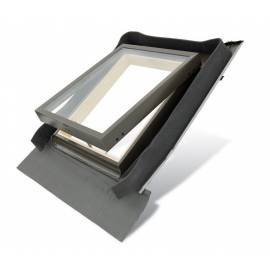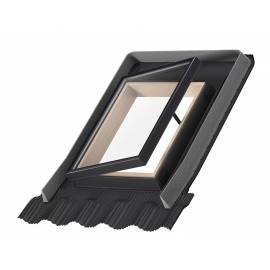Skylights are a valuable architectural feature that enhances natural lighting in a space. However, without proper sealing, they can become a source of problems, such as leaking skylights. Ensuring a tight seal is crucial to prevent water damage, mold growth, and energy inefficiency.
A well-sealed skylight, whether vented or fixed, prevents water infiltration and air leaks, protecting the interior and maintaining energy efficiency. The skylight frame and skylight lens must be sealed effectively to ensure the entire unit is watertight.
Table of Contents
Common Issues with Skylight Leaks
Leaky skylights can result from improper installation, degraded sealant, or damage to the skylight frame. These issues can lead to water stains, dripping water, and drafts. High-quality silicone sealants are often considered the best sealant for skylights due to their durability and weather resistance, providing a robust seal around the skylight lens and frame.
Addressing potential leaks through proper sealing is essential for enjoying the benefits of skylights without the worry of water damage.
Types of Sealants for Skylights
Choosing the best sealant for skylights is crucial to prevent leaks and ensure a watertight seal. Different types of sealants offer various properties and benefits, making them suitable for specific applications around the skylight frame and skylight lens. Here’s a look at the most common sealants used for skylights:
- Silicone Sealants
Properties and Benefits: Silicone sealants are highly flexible and durable, making them ideal for sealing skylights. They provide excellent adhesion to a variety of surfaces, including glass and metal, which are common materials in skylight construction. Silicone sealant is resistant to UV rays and extreme temperatures, ensuring a long-lasting seal that prevents water damage.
Ideal Applications for Skylights: Silicone sealant is perfect for both fixed skylights and vented skylights. They are particularly effective around the skylight lens and frame, where flexibility is needed to accommodate movement and temperature changes. Silicone caulking can be used to fill gaps and create a watertight seal, preventing a leaky skylight.
- Polyurethane Sealants
Characteristics and Advantages: Polyurethane sealants are known for their strong adhesion and elasticity. They are resistant to abrasion and can withstand harsh weather conditions, making them suitable for outdoor applications.
Suitability for Different Skylight Materials: These sealants work well with a variety of materials, including wood, metal, and plastic. They are a good choice for sealing the frame of skylights, especially in areas where the roof may experience movement or settling.
- Acrylic Sealants
Features and Uses: Acrylic sealants are easy to apply and clean up with water. They are paintable, which makes them a good option for aesthetic applications where the sealant needs to blend with the surrounding surfaces.
Pros and Cons for Skylight Sealing: While acrylic sealants are less flexible than silicone, they are suitable for interior applications where minimal movement is expected. However, they may not be the best choice for areas exposed to constant moisture or extreme temperatures.
- Butyl Rubber Sealants
Durability and Flexibility: Butyl rubber sealants offer excellent flexibility and adhesion, making them ideal for sealing joints and seams. They are particularly effective in preventing leaks and water damage.
Best Use Cases for Skylights: These sealants are well-suited for use around the edges of skylights, especially in areas where the roof meets the skylight frame. They provide a durable seal that can accommodate slight movements and prevent moisture infiltration.
Selecting the right sealant for skylights is essential to prevent leaks and maintain the integrity of the structure. Silicone sealants are often considered the best sealant for skylights due to their flexibility and durability, ensuring a watertight seal that protects against water damage and maintains the flow of natural light into the house. Proper sealing around the skylight frame and lens is crucial to avoid a leaking skylight and ensure long-term performance.
Factors to Consider When Choosing a Sealant for Skylights
Selecting the right sealant for skylights is crucial to ensure a long-lasting, watertight seal that prevents leaks and water damage. Here are key factors to consider:
Compatibility with Skylight Materials
Skylights are typically made from materials like glass, metal, and plastic. It’s essential to choose a sealant that adheres well to these surfaces. Silicone sealants are highly compatible with glass and metal, making them ideal for sealing the edges of skylights. For plastic components, ensure the sealant is specifically formulated to bond with plastic to avoid any gaps that could lead to leaks.
Weather Resistance
Skylights are exposed to various weather conditions, including UV rays, temperature fluctuations, and moisture. A good sealant should withstand these elements without degrading. Silicone sealants are known for their excellent weather resistance, maintaining their integrity even under harsh conditions. This is crucial for both fixed and vented skylights, as it prevents water damage and ensures the skylight remains secure.
Longevity and Durability
The longevity and durability of a sealant are vital to avoid frequent resealing. A durable sealant will maintain its flexibility and adhesion over time, preventing leaks and the need for constant maintenance. Silicone and polyurethane sealants are renowned for their long-lasting performance, making them top choices for skylight applications.
Ease of Application and Curing Time
Ease of application is an important consideration, especially for DIY projects. A sealant that is easy to apply and has a reasonable curing time can make the process of fixing or installing skylights more manageable. Silicone caulk, for example, is user-friendly and typically cures quickly, allowing for a faster completion of the sealing process.
Environmental Impact and Safety
When selecting a sealant, consider its environmental impact and safety. Opt for sealants that are low in volatile organic compounds (VOCs) to minimize environmental harm and ensure indoor air quality. Additionally, ensure the sealant is safe to use around the house, especially if it will be applied near ventilation areas.
Top Recommended Sealants for Skylights
- Silicone Sealants: Known for their flexibility, weather resistance, and compatibility with glass and metal, silicone sealants are often the best choice for skylights. They provide a durable seal that prevents leaks and water damage.
- Polyurethane Sealants: These offer strong adhesion and elasticity, making them suitable for sealing skylight frames and fixing any gaps or cracks that may develop over time.
- Butyl Rubber Sealants: Ideal for areas where the roof meets the skylight, these sealants provide a robust seal that accommodates slight movements and prevents moisture infiltration.
Choosing the right sealant for skylights involves considering material compatibility, weather resistance, durability, ease of application, and environmental impact. By selecting a high-quality sealant, you can ensure a watertight seal that protects your house from water damage and maintains the benefits of natural light through your skylights.
Other products in category: RoofLITE+
£103.33 tax excl.
Other products in category: Velux
£104.17 tax excl.
Preparing the Skylight and Surrounding Area
Before applying a new sealant to your skylight, it’s crucial to prepare the area properly to ensure a strong, long-lasting seal. Start by inspecting the skylight and surrounding roof area for any signs of water damage, such as stains on the ceiling or walls. Check for any gaps or cracks around the skylight frame that may need fixing. Remove any old sealant carefully, ensuring the surface is clean and free of debris. If there are any damaged shingles or other roofing materials, replace them to prevent future leaks. Ensure the area is completely dry before proceeding with the new sealant application.
Step-by-Step Guide to Applying Sealant
- Clean the Surface: Use a mild detergent and water to clean the skylight and surrounding area. Remove any dirt, dust, or debris to ensure the new sealant adheres properly.
- Remove Old Sealant: Carefully scrape away any old sealant using a putty knife or similar tool. Be cautious not to damage the skylight or roof surface.
- Apply Masking Tape: To achieve a clean edge, apply masking tape around the area where the new sealant will be applied.
- Apply the New Sealant: Using a caulk gun, apply the new sealant evenly around the skylight frame. Ensure you fill any gaps or cracks completely to prevent leaks.
- Smooth the Sealant: Use a caulking tool or your finger to smooth the sealant, ensuring it is evenly distributed and adheres well to the surface.
- Remove Masking Tape: Carefully remove the masking tape before the sealant begins to set.
- Allow to Cure: Let the sealant cure according to the manufacturer’s instructions. Ensure the area remains undisturbed and completely dry during this time.
Common Mistakes to Avoid
- Skipping Surface Preparation: Failing to clean and dry the surface can lead to poor adhesion and future leaks.
- Using the Wrong Sealant: Ensure the sealant is compatible with the skylight materials and suitable for outdoor use.
- Applying Sealant in Wet Conditions: Always apply sealant when the area is completely dry to ensure proper curing.
Maintenance Tips for Long-Lasting Seals
- Regular Inspections: Periodically check the skylight for signs of wear or damage, especially after severe weather.
- Address Condensation: Ensure proper ventilation to reduce condensation, which can weaken the seal over time.
- Prompt Repairs: Fix any small leaks or gaps immediately to prevent more significant water damage.
Proper sealing of skylights is crucial to prevent water damage and ensure the longevity of both fixed and vented skylights. Selecting the right sealant involves considering factors such as compatibility with skylight materials, weather resistance, and ease of application. Silicone sealants are often recommended due to their flexibility and durability, making them ideal for creating a watertight seal around the skylight frame and lens. Preparing the skylight area by cleaning and removing old sealant is essential for a successful application. Regular maintenance and prompt repairs can help maintain the integrity of the seal and prevent leaks.
Final Recommendations Based on Specific Needs and Conditions
- For Homes in Harsh Climates: Opt for silicone sealants due to their superior weather resistance and ability to withstand extreme temperatures and UV exposure.
- For Skylights with Metal or Glass Frames: Ensure the sealant is compatible with these materials to prevent adhesion issues and potential leaks.
- For DIY Projects: Choose a sealant that is easy to apply and has a reasonable curing time. Silicone caulk is often user-friendly and effective for most skylight applications.
- For Older Skylights: Regularly inspect and replace any old sealant to prevent leaks and water damage. Address any signs of wear or damage promptly.
- For Homes with Ventilation Concerns: Ensure proper ventilation to reduce condensation around the skylight, which can weaken the seal over time.
By considering these recommendations and tailoring your approach to your specific needs and conditions, you can effectively seal your skylights and enjoy the benefits of natural light without the risk of water damage.


